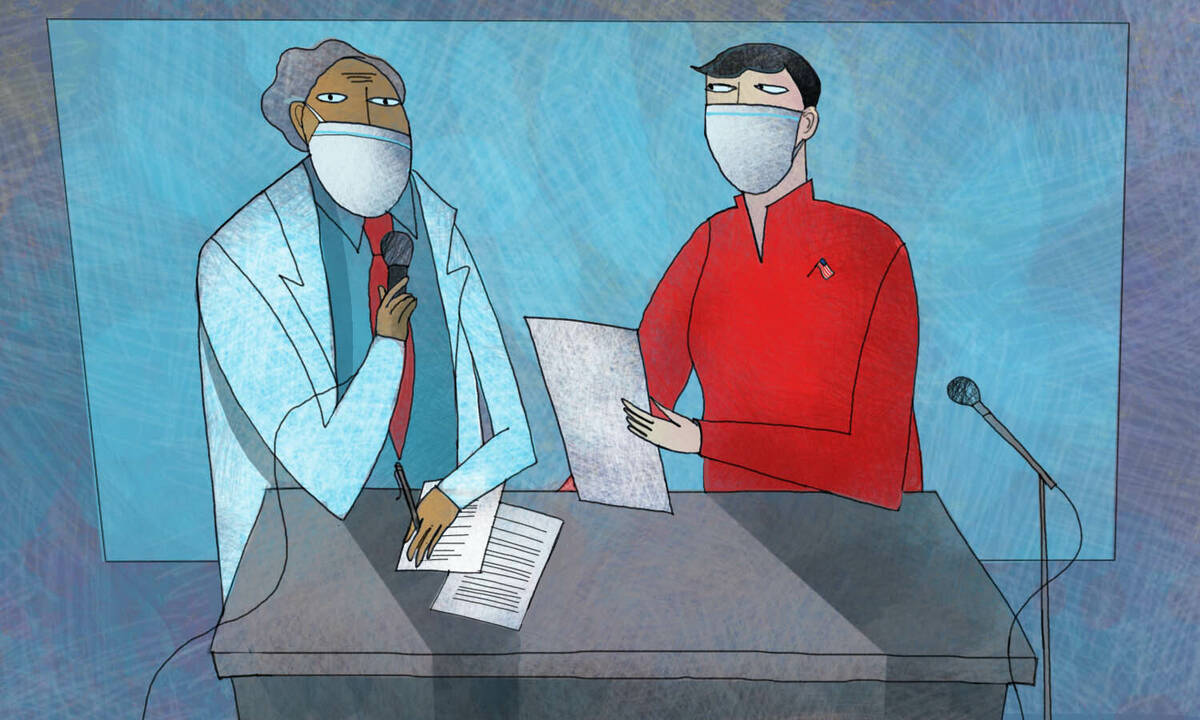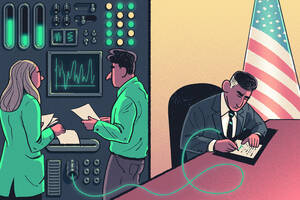But researchers have also learned other important lessons from the pandemic, such as how to mitigate damage to the economy, how to persuade people to adopt safety measures, and how science itself shifts in response to a public-health crisis.
Here we’ll look at some of these findings by Kellogg professors and discuss how they could help policymakers respond to the next crisis.
Recall (if you can stand it) those early days of the pandemic, when everything felt uncertain. When would businesses and schools open? Would a vaccine work? How bad was the next surge going to be?
While this particular brand of uncertainty was very new, uncertainty about the future of the economy is a recurring—and problematic—condition that Scott Baker, an associate professor of finance, studies.
Pervasive uncertainty about the future of the economy can cause people to defer making decisions until a clearer picture takes shape. Faced with a rumored tax hike, for instance, the economy tends to slow down. Businesses may hold off on planned investments and individuals may defer big purchases.
Because of these widespread consequences, economists have long been interested in measuring ever-fluctuating levels of “policy uncertainty”: uncertainty about which government policies may be enacted or how they might impact the economy. Baker believes these measures stand to be improved because they mainly focus on the impact of national laws, while ignoring those at the state and local levels.
So, Baker and colleagues created new measures of economic-policy uncertainty—this time, trained on individual U.S. states—that covered roughly four decades. Their analysis showed that for the first time in that time period, the main generators of policy uncertainty during the pandemic were at the state and local, rather than national, levels.
These findings suggest to Baker that, even in the midst of a public-health crisis, there are steps local governments can take to mitigate uncertainty and its negative consequences, such as being clear about what indicators will be used to reopen schools and businesses.
“The pandemic had a lot of effects on the economy, on behavior, and on perceptions of uncertainty,” Baker says. “Some of this is certainly unavoidable given the nature of the pandemic. But I don’t think that all politicians fully appreciate the extent to which households and businesses need some information to be able to plan. And there are a lot of real costs associated with these levels of uncertainty, regarding what the business conditions are going to be in the future.”
Along with uncertainty in the early days of the pandemic came many requests from officials to engage in new behaviors, such as masking and social distancing.
But the number of people who complied with these rules varied greatly across geographies. What accounted for this? And how can policymakers use this knowledge to spur compliance with other helpful public-health behaviors in the future?
Research from finance professors Efraim Benmelech and Paola Sapienza suggests that a key factor might be “civic capital”: the level of trust people have for one another and their willingness to engage in activities that benefit the collective more than the individual, such as voting or donating blood.
Along with colleagues, they conducted research on the extent to which social-distancing behavior early in the pandemic was predicted by civic capital.
They measured social distancing from aggregated cell-phone location data and measured civic capital by examining data such as voting and census-response rates. Their analyses showed that people living in areas high in civic capital were consistently more likely to change their behavior in accordance with officials’ social-distancing recommendations.
The finding offers one way for policymakers and public-health officials to predict how well different populations might adhere to rules meant to protect public health. This could help them tailor the delivery of their guidance.
For example, in areas where civic capital is known to be low, it may be a good idea to issue behavioral guidance through familiar, trusted messengers.
“They could be local religious leaders, celebrities, athletes; you’d have to think creatively,” Benmelech says. “If you believe that civic capital is important, you want to think about mechanisms to overcome the lack of it.”
While that research has implications for the best messengers to convey public-health advisories, other research explores the content of the message itself. After all, the language used to ask people to socially distance varied, with some messages encouraging people to stay healthy, and others cautioning them to keep safe.
Those messages struck a familiar chord with Angela Lee, a professor of marketing, and her coauthor, Kellogg doctoral student Jiaqian Wang. They recognized that emphasis on maintaining good health in a message like “stay healthy” was framed as promoting a positive outcome, while the emphasis on keeping danger at bay in a message like “keep safe” was more about preventing a negative one.
Lee and Wang suspected that a concept called “regulatory fit” would come into play in determining which appeals were most successful. This is the idea that messages are more persuasive when there is a match between someone’s motivations and the way the message is framed.
Lee had observed in her previous research that thinking about ourselves as independent individuals tends to make us want to obtain positive outcomes, while thinking of ourselves as part of a collective tends to evoke a desire to avoid negative ones.
With this in mind, the researchers theorized that encouraging people to stay healthy would work best when the appeal focused on the individual, but encouraging people to keep safe would prove more effective when the appeal focused on the nation.
And indeed, that’s what the researchers found. They surveyed more than 2,100 Americans and found that both kinds of public-health messaging can succeed—but “stay healthy” messages work best when focused on the individual, while “keep safe” messages work best when focused on the collective.
All of this Covid-related research happened because scientists around the world quickly pivoted to study the pandemic.
Understanding any new public-health emergency will require a certain amount of pivoting. But the sheer size of some of these pivots could ultimately impact the quality of the work that emerges.
To examine the impact of these pivots, strategy professor Benjamin Jones
and assistant professor Ryan Hill, as well as Dashun Wang, a professor of management and organizations, teamed up with other researchers to examine the 89,000 Covid-19 research papers produced in 2020.
They found that 67 percent of the scientists authoring these papers had no prior research that was relevant to Covid. Even scientists who had produced especially relevant prior work pivoted further when writing Covid-19 papers than they normally do.
Time will tell the lasting impact of these papers. But the researchers found that, historically, when scientists reach too far to study new topics, the research suffers. In examining 36 million papers from 1970–2020, it became clear that the larger a scientist’s pivot, the lower the impact of that work, as measured in citations.
These findings suggest that policymakers might wish to proactively work to build a bigger bench of scientists with wide-ranging expertise. This will help ensure that when the next crisis hits, there will be scientists ready who don’t need to pivot too far to contribute valuable research.
Wang, who is director of Kellogg’s Center for Science of Science and Innovation (CSSI), and Jones also wanted to understand how well policymakers were using all this new science.
Along with CSSI researchers Jian Gao and Yian Yin, they analyzed over 37,000 policy documents across 114 countries—all major economies except mainland China—from January through late May of 2020. This included publications from government agencies, think tanks, and intergovernmental organizations, like the World Health Organization.
Overall, their study revealed good news: “We found that global policy attention to Covid-19 closely follows the number of cases and draws heavily on the rapidly evolving science,” Wang says.
Moreover, the scientific papers cited by pandemic policy documents were more likely to be those referred to more often by other scientific papers. Research referenced in policy papers had 40 times more citations, on average, than a broader set of Covid research articles not included in policy documents.
“In an era of misinformation, some good news is that policy documents emphasize vetted science, including the latest science,” Jones says.




